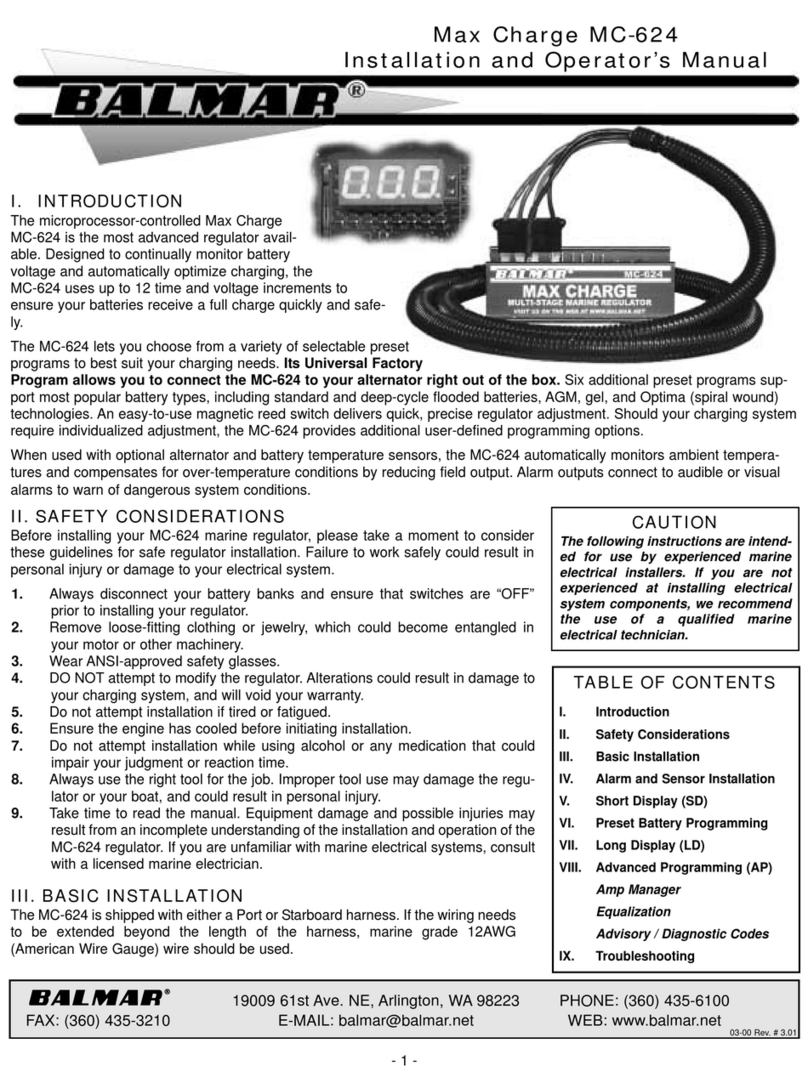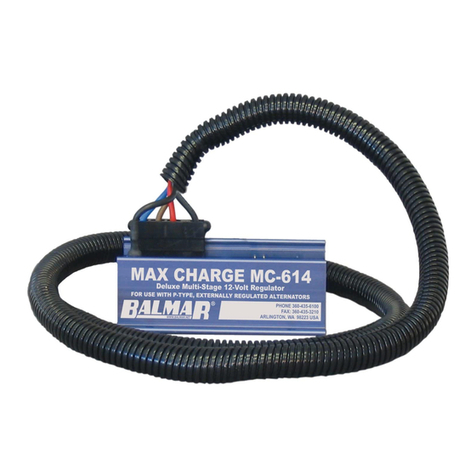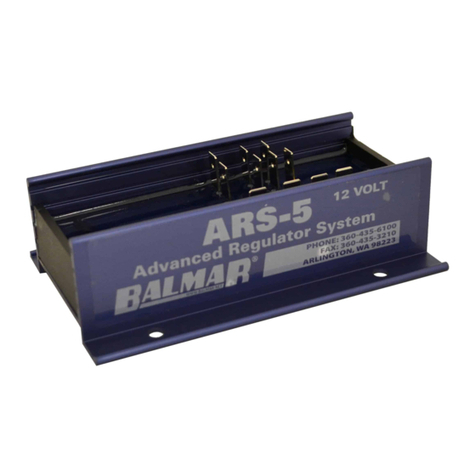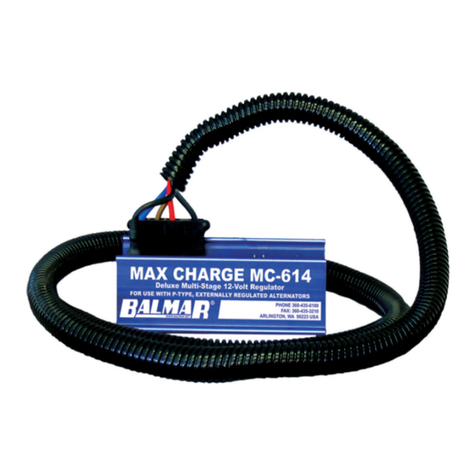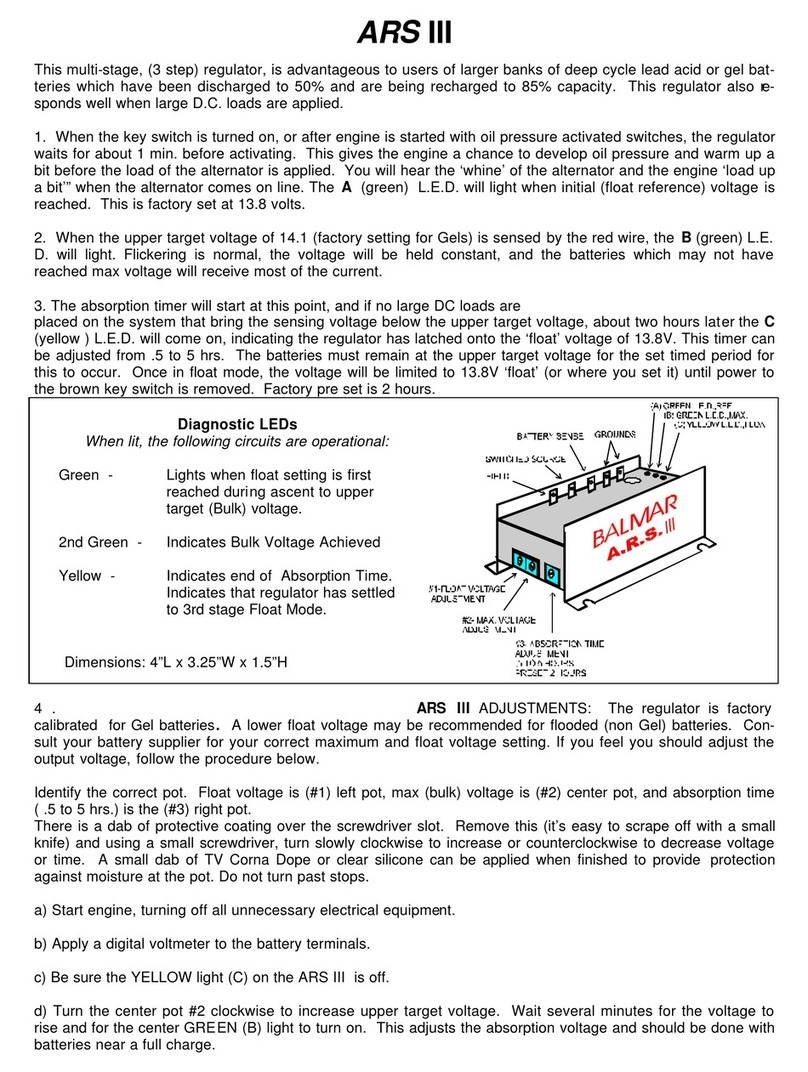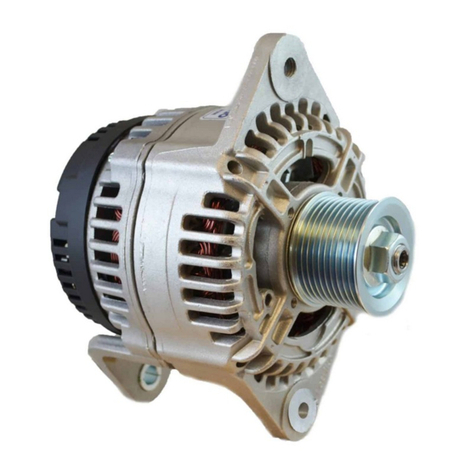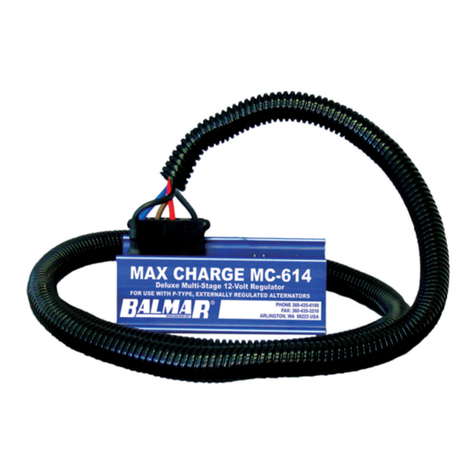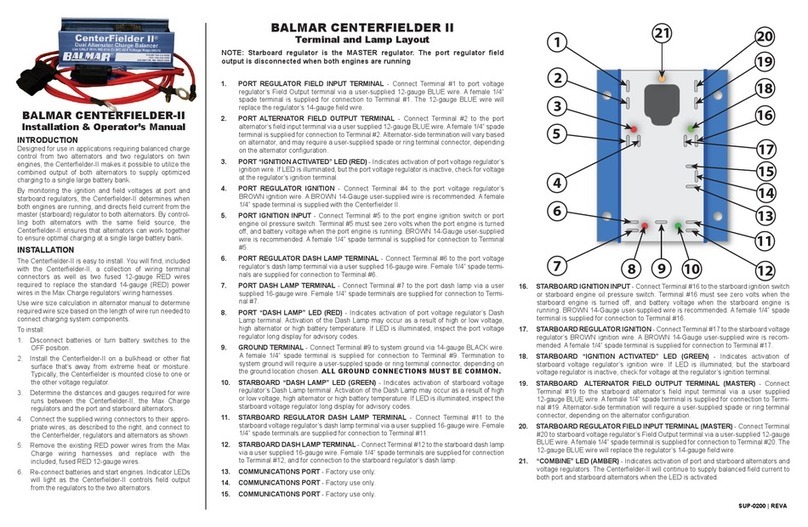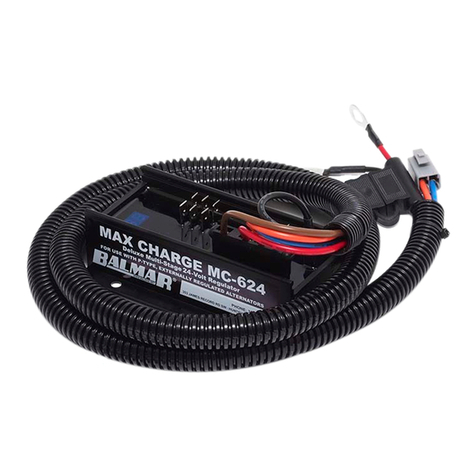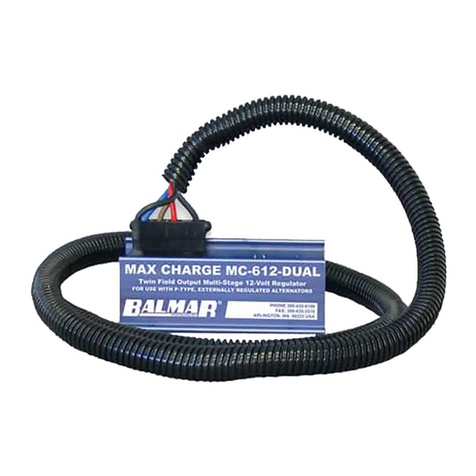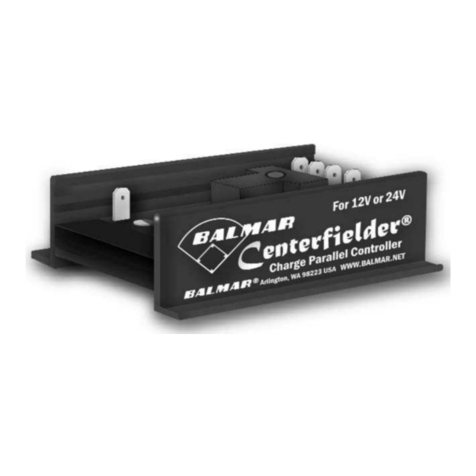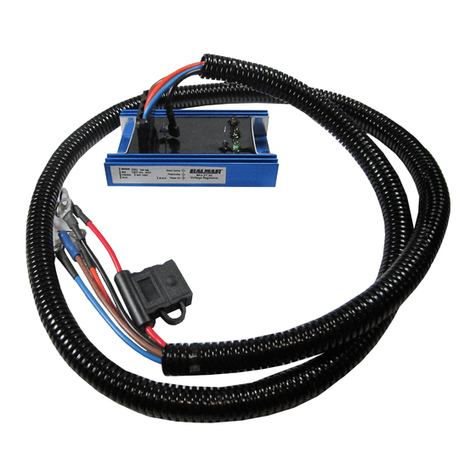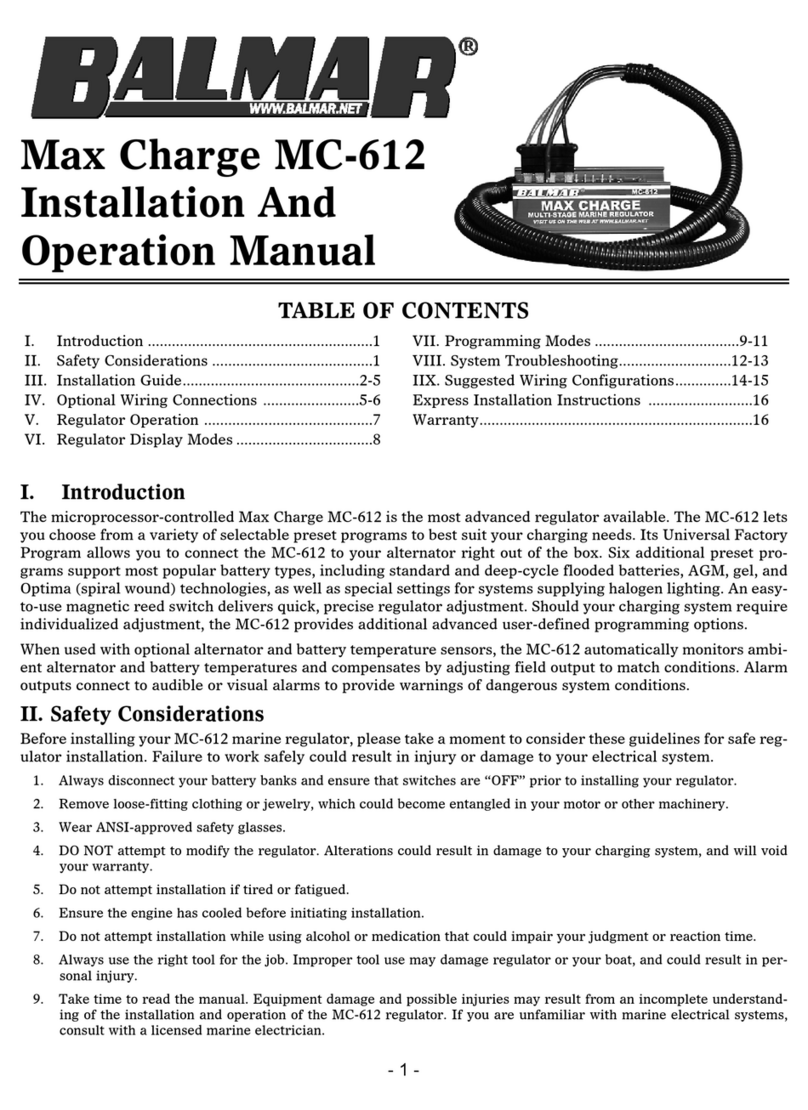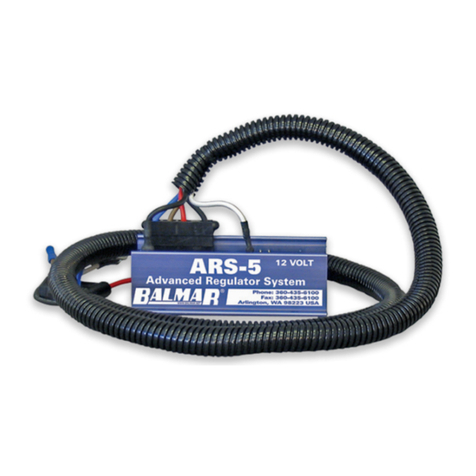CAUTION: The following instructions are intended for use by experienced marine -
electrical installers. If you are not experienced at installing electrical system components,
Basic Wiring Installation
The regulator’s wiring harness includes six wires required for standard installation. Four of those wires are connected to
the regulator via a Ford-style plug connector that’s pre-installed on the regulator. These wires include the Stator (WHITE),
Power (RED), Ignition (BROWN) and Field (BLUE). In addition, the harness includes a separate Ground. The proper ter-
minal connection points for these, and additional wiring connections, are illustrated below.
- 2 -
1. FIELD OUTPUT - Provides external (P-type) alternator control.
BLUE wire in regulator wiring harness.
2. STATOR INPUT - Provides voltage input from the alterna-
tor’s AC stator circuit. WHITE wire in regulator’s wiring harness.
3. POWER INPUT - Supplies power to operate the regulator and pro-
vides battery voltage for sensing. RED wire included in wiring har-
ness.
4. IGNITION INPUT - Connects to a switched source of battery voltage
(to ignition switch or oil pressure switch). BROWN wire in regulator
wiring harness.
5. TACHOMETER OUTPUT - AC voltage output to provide a signal for
an electrical tachometer. User supplied wire is required.
6. GROUND INPUT - Connects regulator to system ground via alterna-
tor ground terminal. Loose BLACK wire included in regulator wiring
harness or to second wiring harness.
7. UNDERVOLTAGE SENSE - Connects to positive battery voltage.
8. GREEN INDICATOR LED - Indicates that the regulator’s power is
on.
9. RED INDICATOR LED - Indicates that the alternator is providing sta-
tor output. Can be used as a signal that the alternator is providing
charging output to the batteries.
10. YELLOW INDICATOR LED - Indicates that the regulator is providing
output to the alternator.
11. ORANGE INDICATOR LED - Illuminates if battery voltage is below
12.8 volts while the regulator is in operation.
Target Voltage Adjustment
The BRS-2-12-T provides the ability to adjust the maximum (target) charging voltage, making it possible to ensure that
charging is tailored to the type of battery technology being charged. Before adjusting the maximum charging voltage, con-
sult with the manufacturer of the batteries being charged to determine the recommended target charging voltage.
Once you have determined the proper target voltage for your battery type, be sure that your batteries are fully charged
prior to adjustment. Once the engine is started, the voltage should climb to the factory-set target voltage of 14.1 volts.
When the voltage has climbed to 14.1 volts and has stabilized at that voltage level, slowly turn the adjustment pot to raise
or lower the target voltage value. Turn the pot counterclockwise to lower voltage. Turn the pot clockwise to raise voltage.
Connecting an accurate digital multimeter, set on DC volts, between the RED power wire and ground will allow you to
monitor changes in charging voltage as you make your adjustments.
Adjust the pot in small increments as you make your adjustments, and allow the system voltage to stabilize for a few mo-
ments to determine how much more adjustment is required to reach the desired target voltage. Continue adjustment until
the desired voltage is indicated on your meter.
VOLTAGE
ADJUSTMENT
POT
we
- 3 -
Voltage Regulator Testing
Set your voltmeter to 12VDC and connect the negative lead to system ground.
With the ignition turned OFF, check voltage on the RED (power), Secondary RED on Terminal #12 (voltage sense)
BLUE and BROWN (ignition) wires in the regulator plug.
Voltages should be as follow:
• RED wire equal to battery voltage
• Terminal #12 RED wire equal to battery voltage
• BLUE wire zero volts
• BROWN wire zero volts
With the ignition in the ON position (engine not running), check voltage on the RED (power), Secondary RED on Ter-
minal #12 (voltage sense) BLUE and BROWN (ignition) wires in the regulator plug:
• RED wire equal to battery voltage
• Terminal #12 RED wire equal to battery voltage
• BLUE wire between 4V and 11V
• BROWN wire equal to battery voltage
PLEASE NOTE: In systems where the ignition (BROWN) wire is supplied power via an oil pressure switch, jump directly
from test #1 to test #3.
With the ignition in the ON position (with engine running at 1,400 rpm fastidle), check voltage on the RED (power),
Secondary RED on Terminal #13 (voltage sense) BLUE and BROWN (ignition) wires in the regulator plug. Volt-
ages should be as follow:
• RED wire equal to battery voltage
• Terminal #12 RED wire equal to battery voltage
• BLUE wire between 4V and 11V
• BROWN wire equal to battery voltage
If voltage is not present on the RED, the BROWN and the Positive Battery Sense Wire, the regulator will not work. If volt-
age is as expected at the RED the BROWN and Positive Battery Sense wire, and there is zero, or an unexpected voltage
reading at the BLUE wire, contact our technical support staff at (360) 435-6100, or e-mail us at balmar@balmar.net.
If all voltages at the regulator meet expectations, yet the alternator is not producing charging current, test the alternator.
The following tests are recommended for determining alternator functionality.
Alternator Testing
TEST #1The following test is used to isolate the alternator and determine if the failure is a result of the alternator. Once
again, testing at either the alternator or regulator is only effective if the wiring, fusing and batteries have been determined
to be in correct working order. The alternator and regulator can be tested for function by determining if a magnetic
exists at the alternator’s pulley shaft or rear bearing. To test:
With the ignition in the OFF position, place the tip of a steel screwdriver near the nut on the pulley shaft or near the rear
bearing of the alternator. There should be no evidence of a magnetic pulling the screwdriver toward the alternator.
(A slight amount of magnetism may be present, due to residual voltage in the alternator.
Engage the ignition, without starting the engine, to activate the voltage regulator. If an oil pressure switch is used, a
jumper between the RED and BROWN wires in the Ford-style plug will activate the regulator.
After allowing time for the regulator’s start-up delay, place the head of a steel screwdriver near the nut on the pul-
leyshaft or near the rear bearing of the alternator. There should be substantial magnetic pull. If a magnetic is
present, the voltage regulator, alternator brushes and rotor are likely to be working properly.
If there is little or no magnetic pull at the pulley shaft or at the rear bearing, initiate the following test:
With the key off and the engine off, remove the large harness plug from the regulator.
Insert the end of a short length of electrical wire to the RED connector slot of the regulator harness and the other end
of the wire to the BLUE connector slot. This bypasses the regulator and tests the alternator and the harness.
Using your steel screwdriver, inspect for a magnetic as described above.
1.
2.
3.
1.
2.
3.
1.
2.
